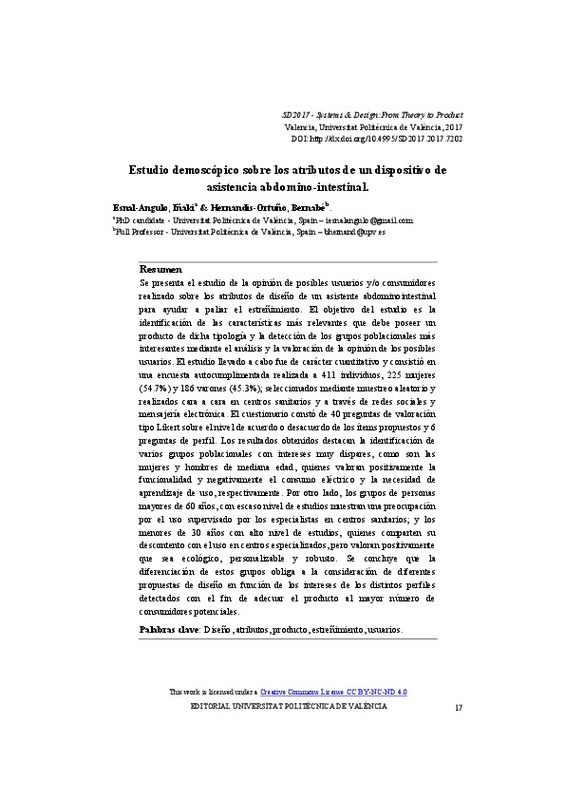JavaScript is disabled for your browser. Some features of this site may not work without it.
Buscar en RiuNet
Listar
Mi cuenta
Estadísticas
Ayuda RiuNet
Admin. UPV
Estudio demoscópico de los atributos de un dispositivo de asistencia abdominointestinal
Mostrar el registro sencillo del ítem
Ficheros en el ítem
| dc.contributor.author | Esnal-Angulo, Iñaki
|
es_ES |
| dc.contributor.author | Hernandis-Ortuño, Bernabé
|
es_ES |
| dc.date.accessioned | 2018-06-06T07:00:09Z | |
| dc.date.available | 2018-06-06T07:00:09Z | |
| dc.date.issued | 2017-11-30 | |
| dc.identifier.isbn | 9788490485828 | |
| dc.identifier.uri | http://hdl.handle.net/10251/103424 | |
| dc.description.abstract | [EN] The study of the opinion of possible users and / or consumers on the design attributes of an abdominointestinal assistant to help alleviate constipation is presented. The aim of the study is the identification of the most relevant characteristics that such typology of a product must possess and the detection of the most interesting population groups by means of the analysis and the evaluation of the opinion of the possible users. The observational study consisted of a self-completed survey of 411 individuals, 225 women (54.7%) and 186 men (45.3%); selected through random sampling and performed face to face in health centers and through social networks and electronic messaging. The questionnaire consisted of 40 Likert-type assessment questions on the level of agreement or disagreement of the proposed items and 6 profile questions considering age, gender, nationality, level of education, constipation, and evacuation frequency. The results obtained highlight the identification of several population groups with very different interests, such as middle-aged women and men, who value above all the functionality and negatively the electric consumption and the need for learning of use, respectively. On the other hand, groups of people over 60 years of age, with low level of studies show a concern about the use supervised by specialists in health centers; and those under 30 with a high level of education, who share their discontent with the use in specialized centers, but value positively that it is ecological, customizable and robust. It is concluded that the differentiation of these groups forces the consideration of different design proposals according to the interests of the different profiles detected in order to adapt the product to the greater number of potential consumers. | es_ES |
| dc.description.abstract | [ES] Se presenta el estudio de la opinión de posibles usuarios y/o consumidores realizado sobre los atributos de diseño de un asistente abdominointestinal para ayudar a paliar el estreñimiento. El objetivo del estudio es la identificación de las características más relevantes que debe poseer un producto de dicha tipología y la detección de los grupos poblacionales más interesantes mediante el análisis y la valoración de la opinión de los posibles usuarios. El estudio llevado a cabo fue de carácter cuantitativo y consistió en una encuesta autocumplimentada realizada a 411 individuos, 225 mujeres (54.7%) y 186 varones (45.3%); seleccionados mediante muestreo aleatorio y realizados cara a cara en centros sanitarios y a través de redes sociales y mensajería electrónica. El cuestionario constó de 40 preguntas de valoración tipo Likert sobre el nivel de acuerdo o desacuerdo de los ítems propuestos y 6 preguntas de perfil. Los resultados obtenidos destacan la identificación de varios grupos poblacionales con intereses muy dispares, como son las mujeres y hombres de mediana edad, quienes valoran positivamente la funcionalidad y negativamente el consumo eléctrico y la necesidad de aprendizaje de uso, respectivamente. Por otro lado, los grupos de personas mayores de 60 años, con escaso nivel de estudios muestran una preocupación por el uso supervisado por los especialistas en centros sanitarios; y los menores de 30 años con alto nivel de estudios, quienes comparten su descontento con el uso en centros especializados, pero valoran positivamente que sea ecológico, personalizable y robusto. Se concluye que la diferenciación de estos grupos obliga a la consideración de diferentes propuestas de diseño en función de los intereses de los distintos perfiles detectados con el fin de adecuar el producto al mayor número de consumidores potenciales. | es_ES |
| dc.format.extent | 15 | es_ES |
| dc.language | Español | es_ES |
| dc.publisher | Editorial Universitat Politècnica de València | es_ES |
| dc.relation.ispartof | Systems & Design: From Theory to Product | es_ES |
| dc.rights | Reconocimiento - No comercial - Sin obra derivada (by-nc-nd) | es_ES |
| dc.subject | Diseño | es_ES |
| dc.subject | Atributos | es_ES |
| dc.subject | Producto | es_ES |
| dc.subject | Estreñimiento | es_ES |
| dc.subject | Usuarios | es_ES |
| dc.subject | Design | es_ES |
| dc.subject | Attributes | es_ES |
| dc.subject | Product | es_ES |
| dc.subject | Constipation | es_ES |
| dc.subject | Users | es_ES |
| dc.title | Estudio demoscópico de los atributos de un dispositivo de asistencia abdominointestinal | es_ES |
| dc.type | Capítulo de libro | es_ES |
| dc.type | Comunicación en congreso | es_ES |
| dc.identifier.doi | 10.4995/SD2017.2017.7202 | |
| dc.rights.accessRights | Abierto | es_ES |
| dc.contributor.affiliation | Universitat Politècnica de València. Escuela Técnica Superior de Ingeniería del Diseño - Escola Tècnica Superior d'Enginyeria del Disseny | es_ES |
| dc.contributor.affiliation | Universitat Politècnica de València. Departamento de Ingeniería Gráfica - Departament d'Enginyeria Gràfica | es_ES |
| dc.description.bibliographicCitation | Esnal-Angulo, I.; Hernandis-Ortuño, B. (2017). Estudio demoscópico de los atributos de un dispositivo de asistencia abdominointestinal. En Systems & Design: From Theory to Product. Editorial Universitat Politècnica de València. 17-31. https://doi.org/10.4995/SD2017.2017.7202 | es_ES |
| dc.description.accrualMethod | OCS | es_ES |
| dc.relation.conferencename | Systems & Design 2017 | es_ES |
| dc.relation.conferencedate | November 30- December 1,2017 | es_ES |
| dc.relation.conferenceplace | Valencia, Spain | es_ES |
| dc.relation.publisherversion | http://ocs.editorial.upv.es/index.php/SD/SD2017/paper/view/7202 | es_ES |
| dc.description.upvformatpinicio | 17 | es_ES |
| dc.description.upvformatpfin | 31 | es_ES |
| dc.type.version | info:eu-repo/semantics/publishedVersion | es_ES |
| dc.relation.pasarela | OCS\7202 | es_ES |








